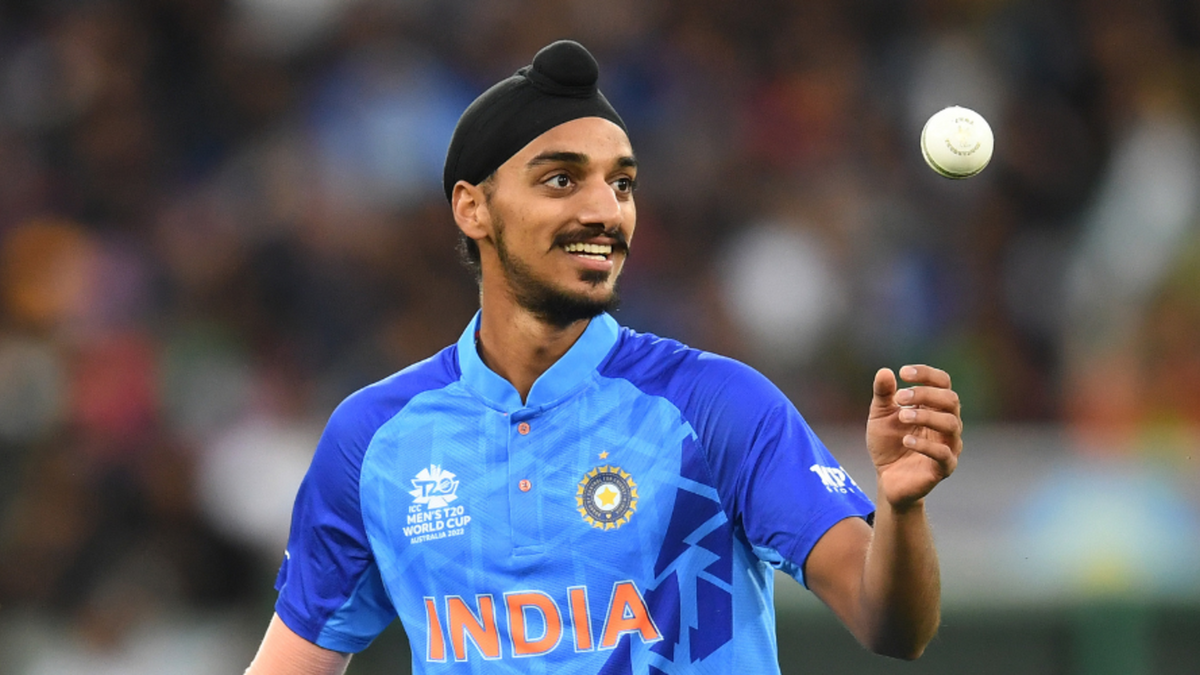
Arshdeep Singh burst onto the scene and found his spot in the India team primarily due to his death-bowling exploits. His new-ball nous, though, is just as impressive, writes Shashwat Kumar.
Ahead of the encounter against Pakistan, Arshdeep Singh – the youngest member of India’s T20 World Cup squad – would have known he had a big role to play. In Jasprit Bumrah’s absence, there was still a question mark over the exact bowling attack, and while Arshdeep had hardly put a foot wrong since his international debut, it was a question of how India’s seamers will balance their new-ball and death-bowling duties. Eventually, it was Arshdeep partnering Bhuvneshwar Kumar at the top, and the seamer repaid India’s faith handsomely, picking up a three-wicket haul.
What was more impressive was how comfortable he looked during the powerplay. He was trialled as a potential new-ball bowler at the Asia Cup but was not very successful, only picking up two wickets in nine overs and conceding 8.33 runs per over. Against Pakistan, though, Arshdeep carried himself like a seasoned new-ball bowler. That was not easy, considering he was playing his very first T20 World Cup game. Almost 90,000 spectators were cheering their lungs out and he was up against Babar Azam. At the back of his head, there could still have been thoughts about the dropped catch against Pakistan at the Asia Cup, which had led to plenty of criticism back home.
The first ball he bowled, however, was bereft of any early jitters. He started the ball on the middle stump and got it to curve back into Babar very late. The Pakistan captain, probably expecting the ball to not move as much, fell over to the off side. It thudded into his front pad, and the umpire had no hesitation in raising his finger. In the rest of that over, Arshdeep caused Shan Masood all sorts of problems too. He swung the ball away from him before bringing the odd delivery back into him. His best, though, was perhaps reserved for Mohammad Rizwan, arguably the most consistent T20 batter going around.
Arshdeep’s second over saw him largely angle the ball across Rizwan. The wicketkeeper had a couple of nibbles at them and was perhaps lucky to not edge them through to Dinesh Karthik. Just when it seemed Arshdeep would shape the ball into him, almost producing a Babar-like delivery, he banged it in short. It was the delivery Rizwan was probably least expecting, considering how much assistance the left-arm pacer had been getting. Also, Arshdeep isn’t really an express quick.
That particular moment encapsulated how the India seamer had out-thought Rizwan and how he had the ball on a string in the first few overs. It was also the first time a bowler had dismissed both Babar and Rizwan in the powerplay since they began opening together for Pakistan. The twin dismissals, apart from denting Pakistan’s confidence, allowed India to keep a lid on the run-scoring. Pakistan were then forced to consolidate, meaning that they had to eventually be content with a total of 159 – a target India just about managed to chase down.
It also highlighted how Arshdeep, despite not being looked upon as a typical new-ball bowler, had all the tools to succeed in the powerplay. His overall numbers during that phase are not exceptional, although they are not too shabby either. So far, Arshdeep averages 25.11 in the powerplay and has picked up 26 wickets, striking every 19.38 balls. The median has been maintained in 2022, where he averages 24.21 and strikes every 19.28 balls. In T20Is, though, he averages 19.6 and has a strike rate of 15.6, indicating that he relishes the responsibility of bowling in the powerplay for India.
When Arshdeep made his T20I debut against England, it was primarily due to his ability to keep things tight at the death; in IPL 2022, he had the second-best economy rate at the death (minimum 100 balls bowled), only behind Jasprit Bumrah. Thus, when he showed skill with the new ball too, it was a refreshing sight for Indian fans. With each passing game, he seems to have understood how to control the movement he can extract as well. He portrayed it against South Africa in the series that preceded the T20 World Cup. More importantly, he followed it up in a high-pressure game against Pakistan at the MCG.
Arshdeep ticking off the powerplay pressure challenge will add another string to India’s bowling bow. Bowlers who can bowl effectively in different phases are a luxury, especially in the shortest format. If Arshdeep can continue bowling incisively in the powerplay, it could help India fill the massive Bumrah-shaped void at the T20 World Cup. Those are huge boots to fill, considering Bumrah is arguably the best pacer in white-ball cricket and has the ability to excel in different phases. Add to that the fact that Arshdeep only made his debut a few months ago and has not been entrusted with as much responsibility previously, and you understand why this is such a tough gig, even for someone as talented as him.
After being remarkably consistent in the IPL, and continuing to excel on the biggest stage in his first World Cup, it suggests that Arshdeep might have the tools to be a great bowler in the long run. So far, the early evidence is very encouraging and that, for the moment, is enough to get excited about.
Bet365 will be Live Streaming all of the T20 World Cup matches direct to your iPhone, iPad or Android device, as well as desktop. This means that every T20 World Cup fixture will be available to bet365 customers wherever they are in the world.








